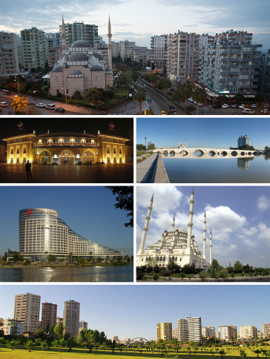Adana
| Adana | ||
|---|---|---|
| Metropolitan municipality | ||

Top: A view from Çukurova, 1 st left: Adana station, 1st right:Taşköprü, 2nd left: Sheraton Adana, 2nd right: Sabancı Central Mosque, Bottom: White Houses neighborhood.
|
||
|
||
| Location of Adana | ||
| Coordinates: 37°0′N 35°19.28′E / 37.000°N 35.32133°ECoordinates: 37°0′N 35°19.28′E / 37.000°N 35.32133°E | ||
| Country |
|
|
| Province | Adana | |
| Founded | 6000BC (8017 years ago) | |
| Incorporated | 1871 (145 years ago) | |
| Districts | Seyhan, Yüreğir, Çukurova, Sarıçam | |
| Government | ||
| • Type | Mayor-council government | |
| • Body | Adana Metropolitan Municipality | |
| • Mayor | Hüseyin Sözlü (MHP) | |
| Area | ||
| • Total | 1,945 km2 (751 sq mi) | |
| Elevation | 23 m (75 ft) | |
| Population (2016) | 1,736,564 | |
| • Density | 892.83/km2 (2,312.4/sq mi) | |
| Time zone | FET (UTC+3) | |
| Postal code | 01xxx | |
| Area code(s) | 0322 | |
| Licence plate | 01 | |
| Website |
www www |
|
Adana (pronounced [aˈda.na]) is a major city in southern Turkey. The city is situated on the Seyhan river, 35 km (22 mi) inland from the Mediterranean Sea, in south-central Anatolia. It is the administrative seat of the Adana Province and has a population of 1.7 million, making it the fifth most populous city in Turkey. Adana-Mersin polycentric metropolitan area, with a population of 3 million, stretches over 70 km (43 mi) east-west and 25 km (16 mi) north-south; encompassing the cities of Mersin, Tarsus and Adana.
Adana lies in the heart of Çukurova, a geo-cultural region that covers the provinces of Mersin, Adana, Osmaniye, and Hatay. Home to six million people, Çukurova is one of the largest population concentrations in Turkey, as well as the most agriculturally productive area, owing to its large stretch of flat, fertile land.
According to numerous sources, the name Adana is derived from the Hittite URUAdaniya of Kizzuwatna, while others assert that it is related to the legendary character Danaus, or to the Danaoi, a mythological Greek tribe who came from Egypt and established themselves in the Greek city Argos. The earlier Egyptian texts for a country Danaja are inscriptions from Thutmosis II (1437 BC) and Amenophis III (1390–1352 BC). After the collapse of the Mycenaean civilization (1200 BC) some refugeees from the Aegean area went to the coast of Cilicia. The inhabitants Dananayim or Danuna are identified as one group of the Sea Peoples who attacked Egypt in 1191 BC during the reign of Ramesses III. Denyen are identified as inhabitants of the city Adana. It is also possible that the name is connected with the PIE da-nu (river) Da-na-vo (people living by the river), Scythian nomad people, water demons in Rigveda (Danavas).
...
Wikipedia


